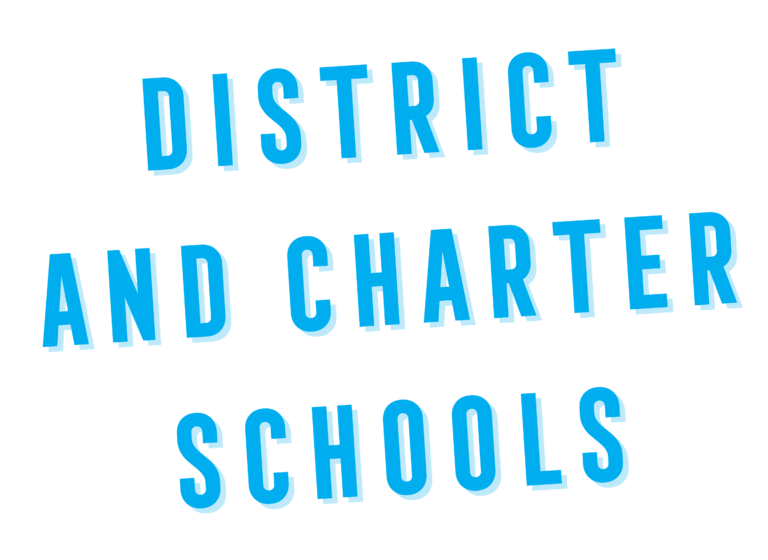Understanding the Differences
District School: The traditional style of public school. Each district covers a geographic region of the state and typically oversees multiple schools. Every school within a district generally teaches the same curriculum, which is approved by board members who are chosen through district-wide elections. By default, students are assigned to the local school that corresponds to their neighborhood, but families may opt for a different district or charter school through Arizona’s “open enrollment” process.
Charter School: An independently-run public school, not associated with a district. Charter schools are founded by private or public bodies under a contract, or “charter,” outlining their terms of operation and accountability standards. Charter schools are subject to statewide academic standards but receive exemptions from various regulations, which allows them to experiment with educational designs and programs. Students from any district can apply to a charter school.
| Question | Charter School | District School |
| Type | Public | Public |
| Funding | Tuition-free. State funded on a per pupil basis; may receive federal funds and philanthropic contributions | Tuition-free. Funded with state & federal revenues and local property tax dollars; may receive philanthropic contributions |
| Admission | Determined by application and lottery if necessary. (No admissions tests) | Determined by geographic region by default; may accept additional students through “open enrollment” |
| Curriculum | Set by independent boards and teachers and tailored to student needs; compliant with state and federal standards | Set by the district and generally uniform throughout all district schools; compliant with state and federal standards |
| Administration | Independent boards, which may contract with non-profit organizations or for-profit companies to provide management services, etc.; Typically authorized by and accountable to the Arizona State Board for Charter Schools | School boards elected by citizens within the district |
Similarities
Both charter and district schools are public. This means they are funded by the state and tuition-free for parents. Additionally, both charter and district schools meet federal and state education standards. Neither districts nor charters may discriminate on the basis of race, sex, special education status, etc.
Both district and charter school students participate in state tests in Arizona under the AzMERIT and Menu of Assessments programs.
Differences
Administration: At charters, independent school governing boards oversee the institution and may contract with non-profit organizations or for-profit companies to manage financial, operational, or educational services. In Arizona, most are authorized by and accountable to the Arizona State Board for Charter Schools. At district schools, governing boards are elected by citizens within the district to manage the finances, operations, and education of students.
Admission: To be admitted to a charter school, a student must apply. If there are more applicants than spots, a lottery system will decide which students get to attend. To be admitted to a district school, a student must live within the geographic boundaries of the district or opt to attend another campus using the Arizona “open enrollment” process.
Curriculum: At charter schools, independent boards and teachers are given discretion over curriculum and teaching methods. State-granted waivers allow charter schools to tailor the classroom or online experience to student needs. At district schools, district board members develop a basic curriculum that all schools and teachers typically use.
Funding: Charter schools are funded by the state on a per pupil basis and can also receive federal funds and contributions from philanthropic donors. District schools are funded by the state and federal government as well as local property taxes, and may also receive donations.
Frequently Asked Questions (FAQs)
What is the idea behind charter schools? What do they provide to the educational system?
The issue of parental choice lays at the heart of the charter school institution. Charter schools recognize that one style of education does not fit every student. Charter schools can provide students with individualized coursework and specialized subject matters that district schools may not. By introducing choice into public education and diversifying education methods, charter schools improve student learning outcomes.
How did charter schools begin?
The introduction of charter schools into American public education is surprisingly recent. In the 1980s, public education indicators fell and the country became concerned about our national prospects. Lawmakers and public administrators were open to innovative solutions. This paved the way for state experimentation, and in 1991 Minnesota passed the first bill authorizing a new type of “chartered” school.
What are charter schools like today?
How many charter schools exist?
- Today, 43 states and the District of Columbia have passed reform incorporating charter schools into their public education systems. The number of charter schools rose from 1,993 in 2001 to 7,011 in 2017.
How many students are enrolled in charter schools?
- Arizona has the highest percent enrollment in charter schools of any state in the United States. 17% of Arizona public school students choose chartered education. National enrollment in charter schools has increased every year since data collection began in 2001.
How are new schools created?
To create a charter school, a group of interested individuals (including teachers, former school officials, parents, or any other individual or organization) must petition their idea and plan to a public sponsor.
In Arizona, this sponsoring body is typically the State Board for Charter Schools. (A handful of charter schools are also authorized by and affiliated with Arizona State University). The sponsor determines if an applicant’s plan is financially, operationally, and educationally sound, in which case it may grant the school approval to open.
Who oversees charter schools?
The charter school’s governing board directs the activities of the school. Charters also have the ability to contract out management services to reputable organizations.
The state sponsor also oversees the progress and long-term management of a charter school. Sponsors hold charter schools accountable to the terms in their contracts, review their performance, and decide whether or not to renew the school’s charter. The sponsor may close charters that fail to meet their educational or financial frameworks.






